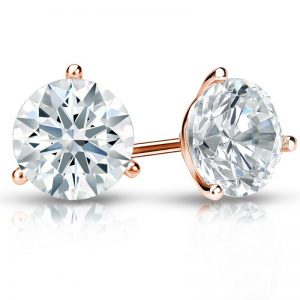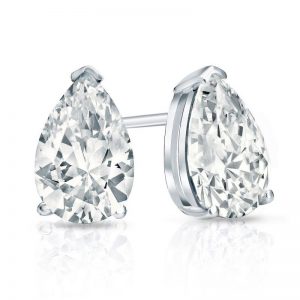
Measuring Diamond Quality
1 Choosing the cut
When it comes to diamond studs Cut is far more important than colour or clarity. In reality the only thing you notice about studs (unless the quality is very poor) is the sparkle and the size. Therefore it’s imperative that the diamond is well cut. Not only will that make the diamond more brilliant, but you need to avoid deeply cut diamonds as they will end up looking too small for their weight and have less visible surface area compared with better cut diamonds.
Pick diamonds cut to look full and shiny. The top cut grade according to the G.I.A. (Gemmological Institute of America) is Excellent, followed by Very Good, Good, Fair, and Poor. Ideally we recommend choosing diamonds rated Between Excellent & Very Good Cut. When you look at the diamond, it should seem full and radiant. A dull cut won’t look appealing on your ear, and a deep cut makes the diamond look too small. Just like shopping for an engagement ring, cut quality is the most important aspect of a diamond. This is because it directly translates to the amount of sparkle and brilliance the diamond displays. (Some argue that, a Good cut is good enough for a diamond stud; the difference between this grade and Excellent will not be readily noticeable for earrings.)
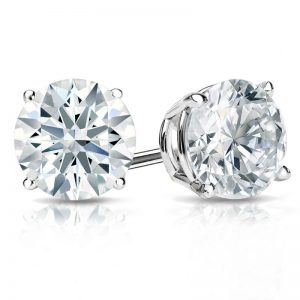
2 Choosing the size
Fist up – you need to know that the carat weight quoted for a pair of diamond studs is total per stone or total per pair. For example, a 1ct set means each earring is 0.50ct as opposed to 2ct. The viewing distances for earrings are much further away compared to engagement rings. Since size is usually the first thing people notice about diamond jewellery, it makes sense for you to prioritize the size (i.e. the carat weight) when shopping for a pair of studs.
When diamonds are mounted onto a stud and worn on the ear, they are usually set lower than when set in a ring and seen in the face up view. Combined with longer viewing distances, the colour and clarity of a diamond will not be readily noticeable by the naked eye.
Choose larger carat weights for more visibility. Carat refers to weight, not size, although heavier diamonds (with an ideal spread) are typically larger and more expensive. As a suggestion, earrings of 0.50ct or less make nice everyday earrings, while heavier 0.50ct or greater, will stand out more and are better for formal occasions. Flaws will be less obvious in smaller diamonds, whilst in larger ones, you may spot flaws or dullness right away.
In general as stones get larger, their flaws increase in number and become more noticeable, (at least in terms of same clarity grade) and any yellow tints in stones of a low-grade colour will be more visible. You don’t need to worry too much about clarity and colour for stones under 1 carat.
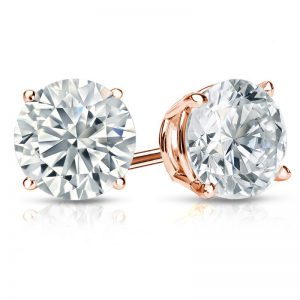
3 Choosing the colour
Fancy coloured diamonds have seen a massive rise in popularity lately. No longer are you limited to just white diamonds – champagne, brown, pink white and yellow are all popular colours for diamond stud earrings. Opting for a coloured stone is a perfect way to add some personality to your studs.
Diamonds are rated on a scale where D is colourless, followed by E and F, up to Z being yellow. You don’t need to spend extra on pure-coloured diamonds. Look for a medium colour quality. Buying high-grade diamonds for stud earrings would be a waste of your money: Look for diamonds rated between F-I colour. Because studs are small and seen at a distance, the quality downgrade won’t make a difference except in your wallet.
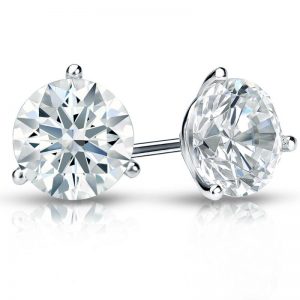
4 Choosing the clarity
Pick stones that aren’t rated high on clarity. Clarity indicates flaws in the diamond, such as cloudiness or scratches. Top diamonds are flawless, marked FL or IF. Near the lower end of the scale are slightly included diamonds, marked SI1/2 or 11. As with colour quality, you can save money by forgoing perfection in favour of diamonds rated a lower clarity. Stud earrings are small and not seen up close like rings are, so no one will notice the difference.
Diamonds with rating lower than S11/2 (such as, I2 or I3) will have noticeable flaws. This will affect the sparkle and brilliance of the stones and show up to the naked eye. Be wary of any retailers mislabelling or upgrading clarity, always inspect the diamonds to avoid poor quality and overpriced stones.
Keep in mind that diamonds in the same clarity grade may differ with respect to how visible their flaws are, and some SI2’s or I1’s stones may have more noticeable inclusions then others. This is why you really need to see the studs you are about to buy – not buy them online – and select diamonds which actually look clean. If
the clarity of the stones is not graded, pick the cheapest ones that look reasonably clean from a normal viewing distance.
Overall the 4Cs should be ranked in the following order of preference:
Cut quality is most important because it determines the beauty of the diamond.
Carat size should be as big as your budget allows.
Colour should be kept in the G-I ranges.
Clarity should be kept in the VS2-SI2 (maybe I1) ranges. (Provided the stones are eye clean)
